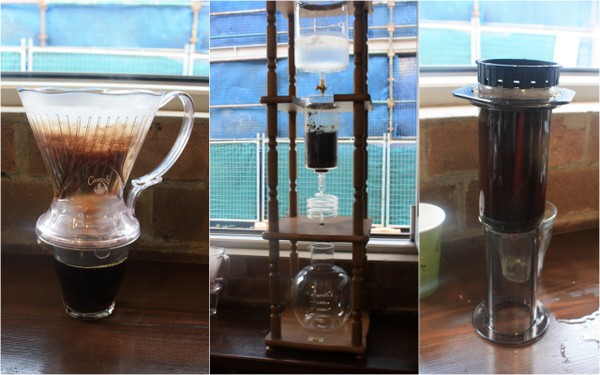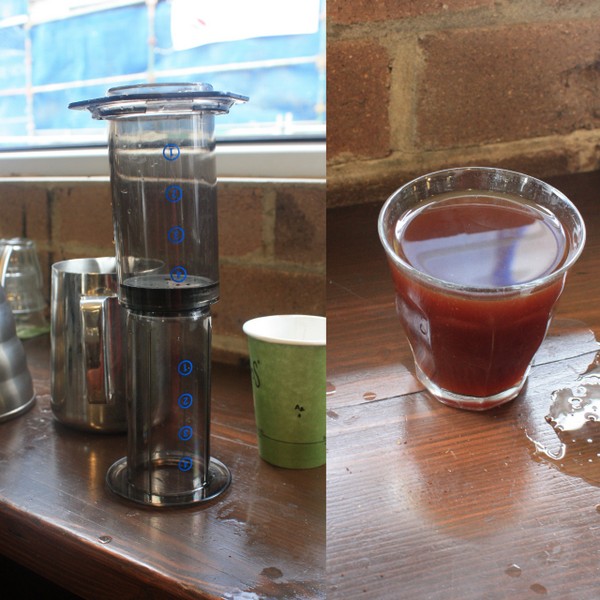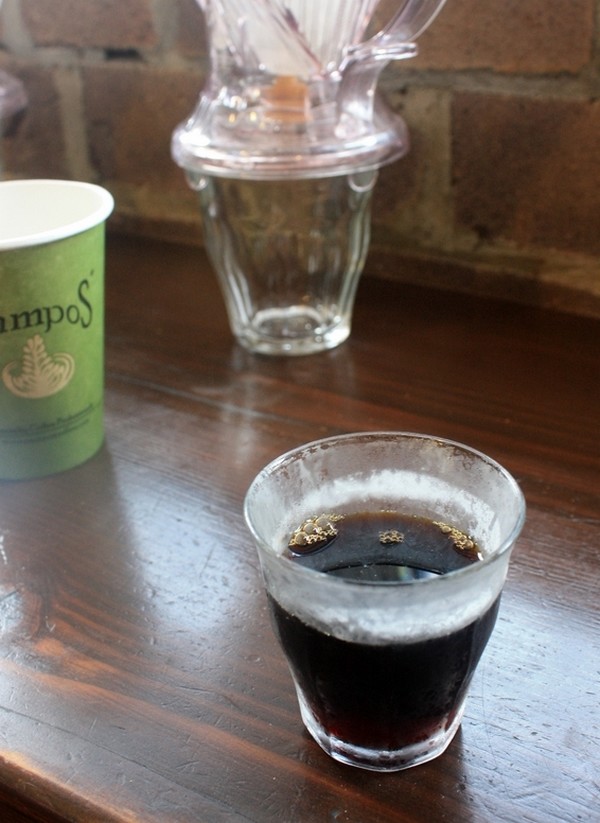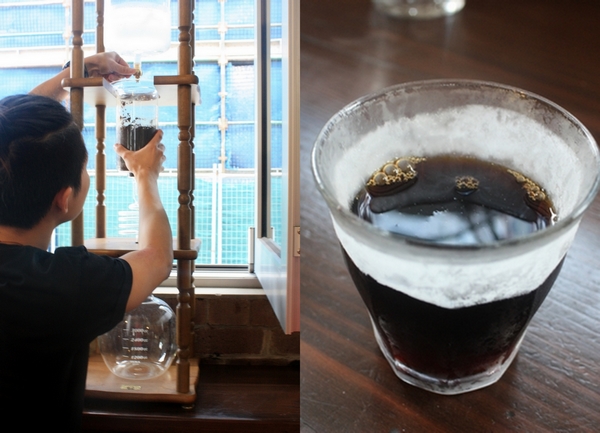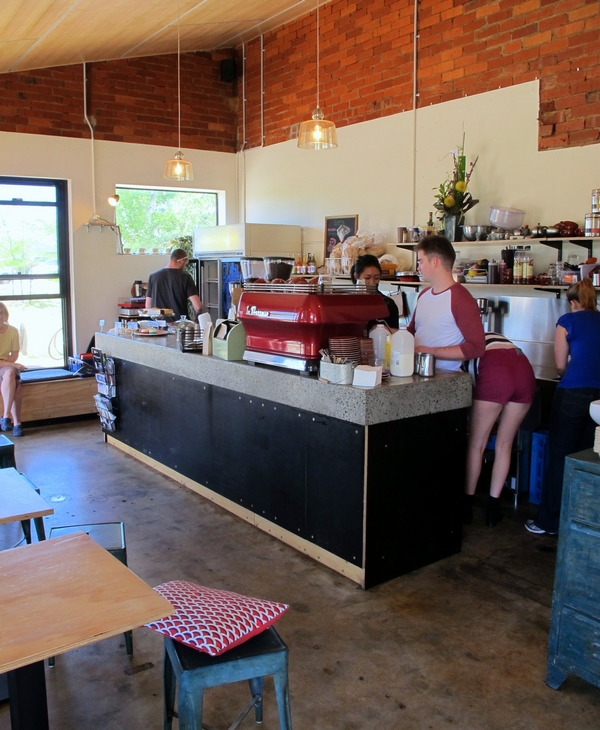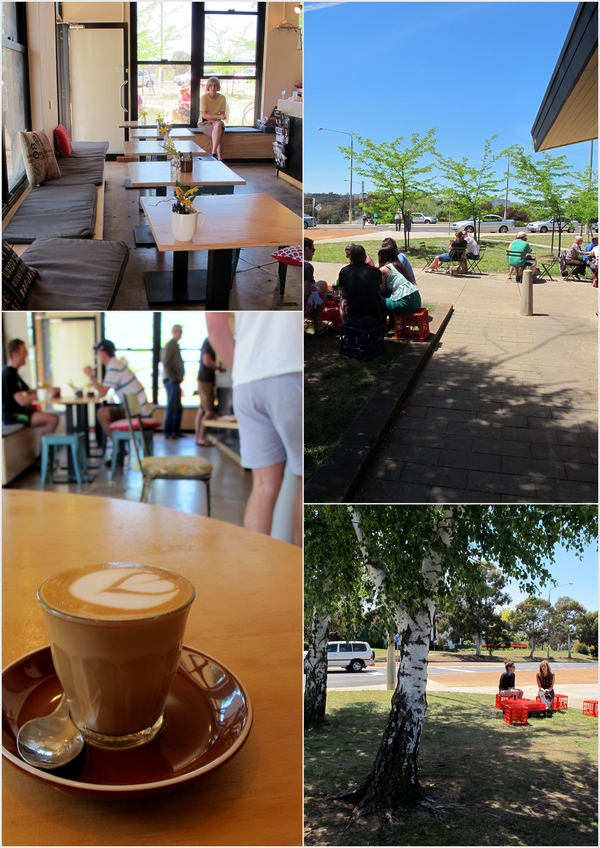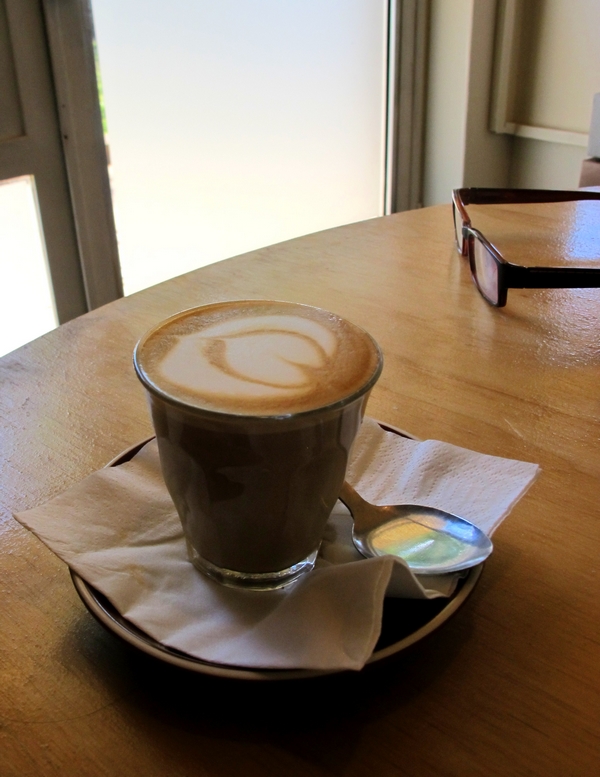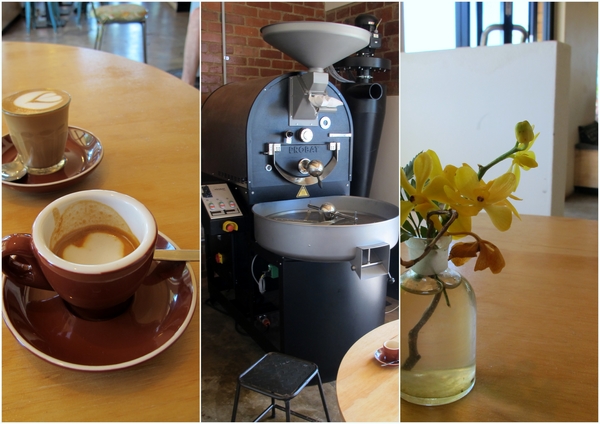Manual brewing, alternative brewing, whatever you want to call it, it’s time to give it a go. DIY brewing methods such as aeropress, cold brew, pourover, syphon and their more well-known cousins such as French press and stove top coffee form another frontier in the exploration of coffee flavour. What’s more, they’re portable, cheap and easy to learn.
embedded by Embedded Video
YouTube
Still not convinced? Then check out my Q&A with Campos’ resident black coffee fanatic David Ruslie above. He talks black coffee culture in Australia, who’s ahead in the Sydney vs. Melbourne black coffee game and why you should give a damn about hands-on coffee brewing.
Other Black Coffee Revolution Posts:
Aeropress
Cold Drip Coffee
In these posts, we look at black coffee – the contraptions, the methods, the how to’s and the why’s. David Ruslie, Campos’ resident black coffee obsessive, walks us through aeropress, cold drip and pourover. He says there’s a growing interest in black coffee, because, sans milk and sugar, it really allows you to explore the flavour profiles of the coffees themselves.
“Coffee appreciation…it’s catching up to wine appreciation. There’s a lot more tasting notes, say with wine you have 200 tasting notes. Well, with coffee, you have 800 tasting notes, it’s really incredible.” David says. Sure, the man or woman on the street doesn’t need to know all 800 to enjoy their ‘new brew’, but it’s handy, he says, to be able to identify which flavours you prefer. You may think you’re not a black coffee drinker, but maybe you just haven’t found the right bean or the right method.
This week David shows us the simplest and most portable of the black coffee methods, aeropress. There are two main ways David uses the aeropress: the ‘normal’ method and the inverted method. In both cases, he advises that you pre-wet the paper filter with a few drops of water beforehand. To be precise, it’s also worth having a digital scale on hand to weigh your coffee and water, but you can also do it by sight. And the reason the water is boiled at the very beginning is that we’re aiming for water temperature of 92-96 degrees. The video gives you a good idea of what the below instructions actually look like in practice. If you’re interested in buying an aeropress, follow this link.
What you need:
– An aeropress
– an aeropress paper filter
– a kettle
– a mug to drink out of
– ground coffee or coffee beans
– a hand grinder (optional)
– a digital scale (optional)
embedded by Embedded Video
YouTube
The Normal Method
1. Boil your kettle.
2. Dampen the paper filter, place it in the aeropress disc and fit the disc into the larger of the two tubes.
3. Place the aeropress, filter end down on your scales and ‘zero’ them. Grind and/or pour in coffee to the desired weight.
4. Place aeropress over a mug or jug, filter side down.
5. Zero your scales again. Pour in 200g of boiled water. Give it a stir. Steep for 45 seconds.
6. Stir once again and place the ‘plunger’ in the aeropress. Slowly push down until all coffee is in the cup (about 20 seconds).
The Inversion/Upside Down Method
1. Boil your kettle.
2. Push the ‘plunger’ into the aeropress tube and turn upside down so that the tube is on top and the plunger is on the bottom.
3. Place it on your digital scales and ‘zero’ them. Grind and/or pour in coffee to the desired weight into the tube.
4. Zero your scales again. Pour in 200g of boiled water. Do not stir. Dampen the paper filter, place it in the aeropress disc and place on top of the upside down aeropress. Steep for 1 minute and 30 seconds.
5. Stir the coffee to break the crust. Fit the disc into the top of the aeropress. Place a jug or mug upside down on it.
6. Flip the entire aeropress 100 degrees. Slowly push down until all coffee is in the cup or jug (about 20 seconds).
Other Black Coffee Revolution Posts:
Cold Drip Coffee
Over the next month, I look at black coffee – the contraptions, the methods, the how to’s and the why’s. David Ruslie, Campos’ resident black coffee obsessive, walks us through aeropress, cold drip and pourover and explains why he’s so passionate about this back-to-basics approach.
“Australian coffee culture is actually milk coffee culture, and I’m trying to change it,” David tells me. Single-handedly trying to convert us from flat-whites-with-one to siphon/cold drip/aeropress? Not so much, Dave says, but he’s excited to share the precision and hands-on nature of black coffee brewing with me. He kindly offered to walk me through these ‘third wave’ or ‘fourth wave’ (whatever it is we’re up to now) methods. We’re going to start with the chemistry lab setup that is cold drip.
David explains that there are two basic methods of coffee making- immersion and percolation, and cold drip is full percolation. This method involves steeping fresh, coarse coffee grounds at room temperature over time, usually around 12 hours. This results in an extremely caffeinated, low acidity, sweet-tasting cold coffee, and a brew that non-espresso drinkers often warm to. ‘It doesn’t actually taste like coffee.’ says David, which is a good way of explaining the flavour- bright, mild and tea-like.
For the cold drip, David used 1500mls of water for 250g of ground coffee, with a resulting yield of 1200ml of cold drip brew. The ideal brewing time is 12-15 hours, as there is no heat to aid extraction. David favours 8-9 drips per 10 seconds
As complex as this chemistry lab setup may look, you don’t necessarily need it to cold brew your own coffee at home. Similar results can be achieved by steeping coffee in a jar or overnight, and then pouring the resulting liquid through a coffee filter and chilling for future use. You can also do this in a French press, as you would for hot coffee but again, overnight.
embedded by Embedded Video
YouTube
The video above demonstrates how cold drip is made. For more info on how to brew you own cold coffee at home, click here.
Are you a cold coffee fan? What’s your fave way to enjoy it?
Other Black Coffee Revolution Posts:
Aeropress
I fear that Canberra, much like Sydney, is in serious danger of burning through its allocation of milk crates. Not because of the popularity of milk, but rather because they serve as seating for the crop of on-trend cafés popping up in old (but not in a retro way) shopfronts all over town. I love/hate this trend for numerous reasons. Milk crates are fine to sit on (with cushioning); they serve as a signal to customers, ‘take this coffee joint seriously’. But while they look incidental, in an ‘oh we were just SO BUSY making GROUNDBREAKING espresso we forgot to buy chairs!’ kind of a way, they are entirely deliberate. This is why there’s a countrywide shortage. I assume.
Red Brick espresso is no exception. Milk crates are scattered plentifully out the front of this Curtin café, and they’ve taken it to another level with the accompanying tables, made of bread crates. I hope there’s not a delivery guy out Fyshwick way somewhere going broke for lack of crates.
We stand at the counter for a while waiting to order, staff seem a little harried so we wait as they hand out the takeaways. We order coffee and seat ourselves in the unmistakeably Canberran, light-filled and cleverly renovated space, which, as we’re in the southside of Canberra, could’ve been anything in a past life- a house, a pharmacy, or a sex shop – all roads lead to rectangular brick structures. The guys behind the espresso machine look like they know what’s what – they roast their own coffee here, and are well and truly the third wave.
The coffee arrives. One of our piccolos is spilled a bit and the young waitress runs and grabs us a serviette. How about a fresh saucer? The spillage is hardly her fault though, the piccolos are almost flat white flat. My macch is cool, as are all the coffees, and nothing about the flavour grabs me. It’s fine, I can’t fault the method on my macch (other than the temperature, and I’m not a hot coffee drinker), so maybe this blend just isn’t for me.
The Red Brick Espresso Hombres were recently quoted in Cafe Culture as saying “We looked at what’s happening elsewhere and said, ‘why can’t we do it here?’ Red Brick ticks all the boxes and, if I lived in this neck of the woods, I’d be here daily. But no matter how many milk crates you give someone to sit on or whether you roast your own beans, it all goes to crap when a teenage girl spills your latte. And for the record, I’ve been back since, the coffee was still lukewarm, and I’ve heard the same from others. But I guess if I was from New York and came to visit my mates in Surry Hills, I’d feel like the café culture here is just a watered down version of what’s going on back home. For all I know the Williamsberg peeps are sitting on upturned shopping trolleys these days. I pray that trend doesn’t make it here.
Red Brick Espresso
4/35 Curtin Place, Curtin ACT 2605
02 6285 1668
http://www.redbrickespresso.com.au/
Monday-Friday 7:30am – 4:30pm
Saturday 7:30am – 4:00pm
Sundays 7:00am – 2:00pm
Sydney CBD cafés usually have a very different feel from those on the city fringe. Your Petty Cash Cafés, you Belljars don’t really exude the same frantic, grab-your-latte-and-raisin-toast-and-run vibe that you get at somewhere like, say, Vella Nero. This is changing, or maybe I’m just paying closer attention. In any case the York Street hub, with the likes of the quirky Shirt Bar and the laneway haven York Lane is a pretty awesome place to be grabbing your coffees and lunches these days.
Palomino Espresso is the newest addition to the area. A few blocks south of Wynyard Station, nextdoor to Stitch, I literally walked straight past it on its second day of trading. And I was actually looking for it. It was only because I was looking for number 61 and the numbers were higher than that that I turned around and had a second look.
I ordered my macch and sat looking out onto the street, and almost every person who walked past did a double take. It wasn’t so much a case of ‘wow, a new café’ as it was ‘how long has that place been open?’. That’s because Palomino Espresso looks like it’s been part of the furniture for yonks. And the service wasn’t very ‘we’ve only been open for two days’ either. If they hadn’t mentioned that fact so many times, I doubt anyone would’ve noticed they’re the NKOTB.
As per usual, I just had coffee. It was good, not particularly photogenic but a nutty, vanilla-y sort of flavour. I was tempted by something that looked suspiciously like a butterfly cake, or at any rate, some variety of cupcake heavy with whipped cream. The breakkies are a bit more city fringe than dine-and-dash – I saw house baked beans and eggs benny on offer, and tons of homemade-looking baked treats. These guys serve Morgans Handcrafted Coffee, the day I went they had two choices, one of which was a Brazilian Single Origin, if that’s what floats your boat. They do cold drip and for soy addicts, it’s bonsoy all the way.
The decor is a tad quirky, with wild west themed knick knacks (there’s a horse figurine inside the espresso machine). To me, it looks like the kind of cafe you’d find in Glebe, I’m not sure why. The high ceilings mean plenty of glass street frontage, there’s enough seating and the staff seem really friendly. I am unsure of their opening hours but I am going to find out. I will be back.
Palomino Espresso
1/61 York Street
Sydney, NSW 2000
Monday-Friday 7:00am – 4:00pm
If you follow the cyclists, you’ll find a good cafe. Turns out those fixies mounted on the wall in your local trendy coffee house aren’t always just for decoration. I challenge you to find somewhere in this wide brown land more cycle friendly than our Nation’s Capital. Canberra has almost as many bike paths as there are roads and so it stands to reason there has to be more than one place to find a good macch. And so early one Canberra morning we rose with the cyclists and followed them to Farmer’s Daughter.
Farmer’s Daughter is at the Yarralumla shops, an old and well-off suburb 5 minutes west of Parliament house. Yeah, like that’s how Canberrans give directions. Anyway, It’s just after 9:00am when we arrive, so we have our pick of tables. By 9:45 the place is pretty much full and the wait is long for those who want a 10:00 or 11:00 am breakky.
The menus are on cute little clipboards and it’s one of those occasions where everything sounds enticing; enough adjectives to intrigue but not so many as to overwhelm. I consider the french toast, described as ‘soft toasted brioche slices served with fresh summer berries and lavender cream’, but I can never quite go past a savoury brunch and so I choose the fried egg bruschetta with romesco. Breakfast dishes hover around the $16 mark, so you know if it’s less than perfect I’ll be sending it back.
The coffee menu is why we’re really here, as farmer’s Daughter serve cold drip and syphon as well as espresso. What I like about their specialty coffee menu is that it’s all written down as part of the normal menu, not on a blackboard or just as something you have to know to ask for. I like that they’ve described what each method involves and tastes like on their menu, leaving you to order the drink, ask questions about it, or not. I know most people drink espresso but I’m sure many are curious to have a go at siphon or cold drip or pourover, but aren’t quite sure where to begin. All too often specialty, back-to-basics coffee can be quite intimidating for the unnanitiated coffee drinker, but not so at Farmer’s Daughter, so assuming that hipster coffee places actually *want* a bigger uptake of these alternacoffees, this is a smart move.
Between the four of us we order a macchiatto (guess who?), a picollo latte, a siphon coffee and a fire and ice espresso shot, which is two shots of a single origin espresso, one in a frozen glass and one in a room temperature glass. This is to show of the differing flavours at different temperatures, as is the Siphon, which you drink cup by cup from hot to lukewarm to appreciate its subtle, tea-like flavour, but also how that flavour changes as the temperature drops. It’s actually quite fun try both of these coffee methods, and there’s nothing patronising or pretentious about the way they’ve each been presented.
The fried egg bruschetta is great, with runny yolks and firm-enough whites, although the romesco has the quality of those cashew and capsicum deli dips – it tastes store bought, although I can’t say for sure. Who cares, it’s delish. The other dishes on our table are equally tasty, from the poached eggs with ‘finishing touches’ to the the ‘no ordinary soldiers’, three toasts with a different topping for each: smoked salmon and crème fraîche on one, parmesan and rocket on another and the third with prosciutto and romesco.
Overall I’d say I enjoyed breakfast at Farmer’s Daughter, I even went back for a second macch (naughty), this time a single origin, the Rwanda Maraba III Sovu Cup of Excellence which is indeed both velvety and fusgy as the Campos website decrees. I will return, bright and early, to sip a syphon and investigate their menu further.
Farmer’s Daughter
27B Bentham St, Yarralumla
Yarralumla, ACT 2600
02 6281 2233
Monday- Saturday 7:00am – 3:00pm
About me
 Sharing easy recipes, hunting down the best coffee. Honest accounts, nothing too serious. Read more...
Sharing easy recipes, hunting down the best coffee. Honest accounts, nothing too serious. Read more...Recent Posts
- Aerpress means no more shit #travelcoffee and #workcoffee
- Why I write and four ace bloggers who do it better
- The five best things I ate in London
- Shoreditch is awesome, airports are not
- I quit sugar? Do I bollocks.
- Cubao Street Food, Alexandria
- The Reformatory Caffeine Lab, Surry Hills
- Brewtown Newtown
- Stay caffeinated over Christmas
- Gumption by Coffee Alchemy, Sydney CBD
Popular posts this month…
 The quest for Mex part 2 – Feisty Chicken Burritos posted on December 21, 2010
The quest for Mex part 2 – Feisty Chicken Burritos posted on December 21, 2010  Sparkling Long Black posted on May 10, 2011
Sparkling Long Black posted on May 10, 2011 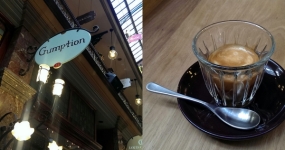 Gumption by Coffee Alchemy, Sydney CBD posted on December 13, 2013
Gumption by Coffee Alchemy, Sydney CBD posted on December 13, 2013  Review – Philips Saeco Intelia posted on January 10, 2012
Review – Philips Saeco Intelia posted on January 10, 2012  Eat. Drink. Blog. Dinner at Kingsley’s Steak and Crab House, Woolloomooloo – 5 November 2011 posted on November 11, 2011
Eat. Drink. Blog. Dinner at Kingsley’s Steak and Crab House, Woolloomooloo – 5 November 2011 posted on November 11, 2011 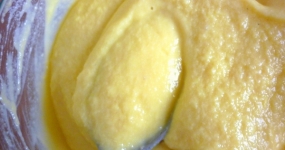 Rich Portuguese Custard posted on November 29, 2010
Rich Portuguese Custard posted on November 29, 2010  Salat Hatzilim posted on January 28, 2011
Salat Hatzilim posted on January 28, 2011  Kosher Whole Orange Cake posted on July 5, 2011
Kosher Whole Orange Cake posted on July 5, 2011
Disclaimer:
All opinions in this blog are mine, an everyday, real-life person. I do not accept payment for reviews and nor do I write sponsored posts. I do not endorse the content of the comments herein.

